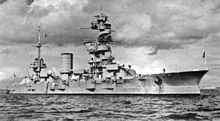Petropavlovsk (ship, 1911)
|
||||||||||||||||||
|
||||||||||||||||||
|
||||||||||||||||||
|
||||||||||||||||||
The Petropavlovsk ( Петропавловск ) was a Gangut- class battleship of the Russian , later Soviet Navy . It was sunk and raised twice and renamed three times. The ships of their class, besides the Petropavlovsk and the Gangut , the Sevastopol and the Poltava , were the first dreadnoughts of the tsarist navy.
history
The keel laying of the Petropavlovsk took place on June 20th July. 3rd / 3rd July 1909 greg. instead of. It was launched on September 9, 1911 at the Baltic shipyard in Saint Petersburg . The tsarist navy took it over on November 3, 1915.
During the Allied intervention campaign in the context of the Russian Civil War , she received three torpedo hits in Kronstadt on August 17, 1919 by the British motor torpedo boat CMB 88 and sank in shallow water. After the salvage and the repairs, which lasted until 1921, the ship, together with the Sevastopol , was occupied by rebel sailors from the end of February to March 18, 1921, who wanted to take action against the Soviet government. (See Kronstadt sailors' uprising ) After the damage caused by aerial bombs and artillery fire, it was put into service again on May 31, 1921 under the new name Marat ( Марат ), after the French revolutionary Jean Paul Marat . In the course of its further service the ship was modernized several times.
In May 1937 the Marat took part in the international fleet show in Spithead on the occasion of the coronation celebrations of King George VI. part.
When the German Reich attacked the Soviet Union in 1941 , the ship was in Kronstadt, where it was attacked by Junkers Ju 87 of Sturzkampfgeschwader 2 on September 21, 1941 . Lieutenant Hans-Ulrich Rudel hit the ship with a 1,000-kg bomb and destroyed the bow and the thereon Tower A, where 326 members of the crew were killed. The ship sank on a level keel on the quay, but despite massive damage and its immobility, it was still capable of fighting as a stationary battery and so intervened in the ground battles against the Wehrmacht . After the end of the Leningrad blockade , the ship, still lying aground, was renamed Petropavlovsk again on May 31, 1943 .
It was only lifted in November 1950 and converted under the new name Volkhov ( Волхов ) as an artillery training ship without its own drive. The ship was decommissioned and scrapped in 1953.
Two main armament gun barrels were used in the reconstruction of the Maxim Gorki I coastal battery from 1954 .
Web links
Individual evidence
- ^ Jürgen Rohwer , Gerhard Hümmelchen : September 1941. In: Chronik des Maritime War 1939–1945 ; Retrieved July 13, 2013

